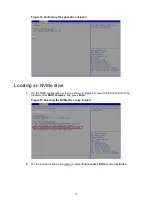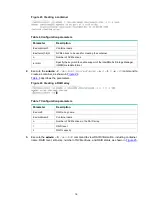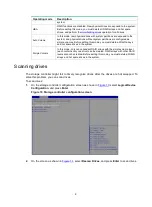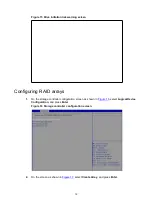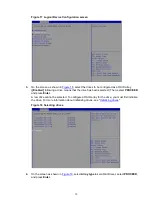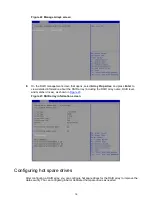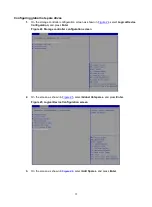
2
shows the minimum number of drives required by each RAID level and the maximum
number of failed drives supported by each RAID level. For more information about RAID levels, see
"Appendix B RAID arrays and fault tolerance."
Table 1 RAID levels and the numbers of drives for each RAID level
RAID level
Min. drives required
Max. failed drives
RAID 0
2
0
RAID 1
2
1
RAID 1E
3
Integer part of
n
/2, where
n
is the number of drives in
the RAID 1E array.
RAID 5
3
1
RAID 6
4
2
RAID 10
4
n
, where
n
is the number of RAID 1 arrays in the RAID
10 array.
RAID 50
6
n
, where
n
is the number of RAID 5 arrays in the RAID
50 array.
RAID 60
8
2
n
, where
n
is the number of RAID 6 arrays in the
RAID 60 array.
Simple Volume
1
0
Hot spare drives
You can configure hot spare drives to improve data security. A hot spare drive is a standby drive that
does not store any data. When a drive in a redundant RAID fails, a spare drive automatically
replaces the failed drive and rebuilds the data of the failed drive.
The storage controller supports the following types of hot spare drives. For more information about
hot spare drive types, see "Storage controller features."
•
Global spare drive.
•
Dedicated spare drive.
•
Pooled spare drive.
Restrictions and guidelines for configuring RAID
•
As a best practice, configure RAID with drives that do not contain RAID information.
•
To build a RAID successfully and ensure RAID performance, make sure all drives in the RAID
are the same type (HDDs or SSDs) and have the same connector type (SAS or SATA).
•
For efficient use of storage, use drives that have the same capacity to build a RAID. If the
drives have different capacities, the lowest capacity is used across all drives in the RAID.
•
If you use one physical drive to create multiple RAIDs, RAID performance might decrease in
addition to increased maintenance complexities.
High speed read/write cache
For the RAID-P430-M1 and RAID-P430-M2 storage controllers, you can enable caching on the
storage controller by using ARCCONF commands. For more information, contact Technical
Support.
Содержание UniServer E3200 G3
Страница 35: ...19 Figure 29 Selecting the RAID volume to be deleted...
Страница 116: ...56 Figure 96 Controller Configuration screen...
Страница 220: ...61 Figure 109 Selecting Main Menu 2 Select Controller Management and press Enter...
Страница 243: ...84 Figure 153 Confirming the operation...
Страница 293: ...50 Figure 89 Clearing completion...
Страница 382: ...21 Figure 27 Storage controller information...
Страница 389: ...7 Figure 8 Identifying a storage controller 2...

